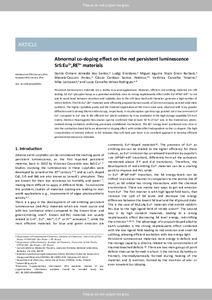Abnormal co-doping effect on the red persistent luminescence SrS:Eu2+,RE3+ materials
Almeida dos Santos Danilo Ormen; Giordano Luidgi; Lastusaari Mika; Portes Marcelo Cecconi; Santos Pedroso Cassio Cardoso; Stock Grein Barbará Miguel Aguirre; Teixeira Veronica Carvalho; Veloso Rodrigues Lucas Carvalho
Abnormal co-doping effect on the red persistent luminescence SrS:Eu2+,RE3+ materials
Almeida dos Santos Danilo Ormen
Giordano Luidgi
Lastusaari Mika
Portes Marcelo Cecconi
Santos Pedroso Cassio Cardoso
Stock Grein Barbará Miguel Aguirre
Teixeira Veronica Carvalho
Veloso Rodrigues Lucas Carvalho
ROYAL SOC CHEMISTRY
Julkaisun pysyvä osoite on:
https://urn.fi/URN:NBN:fi-fe2021042822756
https://urn.fi/URN:NBN:fi-fe2021042822756
Tiivistelmä
Persistent luminescence materials are a reality in several applications. However, there is still a lack of efficient red-emitting materials. SrS:Eu2+ phosphor is a potential candidate since its strong nephelauxetic effect shifts Eu(2+)4f(6)5d(1) -> 4f(7) to red, and its weak bond between strontium and sulphide, due to the soft base-hard acid character, generates a high number of intrinsic defects. SrS:Eu2+,RE3+ materials were efficiently prepared by two rounds of 22 min microwave-assisted solid-state synthesis. The highly crystalline purity and the material organization at the micro-scale were observed with X-ray powder diffraction and scanning electron microscopy, respectively. X-ray absorption spectroscopy revealed a low amount of Eu2+ compared to Eu3+ due to the efficient Eu2+ photo-oxidation by X-ray irradiation in the high storage capability SrS host matrix. Electron paramagnetic resonance spectra confirmed that at least 50% of Eu2+ ions in the material are photo-oxidized during excitation, reinforcing the previously established mechanisms. The RE2+ energy level positioned very close to or into the conduction band led to an abnormal co-doping effect, with similar effects independent of the co-dopant. The high concentration of intrinsic defects in SrS indicates that the soft-hard pair host is an excellent approach to develop efficient persistent luminescence materials.
Kokoelmat
- Rinnakkaistallenteet [19207]
